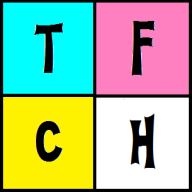Q&A About TFCH

Earlier this week, J. Todd Scott emailed me with both praise and questions about The Four Color Hack. What follows is the bulk of my response to Todd, posted with his kind permission:
Question 1: So now that the villain is locked into the d12 bubble, what does that really mean?
Keep in mind that TFCH should always start and end with the narration. So, when the villain’s turn comes around, he’s trapped in a Positronic Bubble d12. That means, among other things, he’s not moving too far. He’s also not attacking through the bubble with effects that can be blocked by a Positronic Bubble. For the sake of clearer examples, let’s assume the villain is Chimera, and that Professor Positron is level 1.
Question 2: How does that d12 come into play?
In addition to the narrative effects, the Positronic Bubble d12 has 7 protection and 1d12 Hit Points. The player rolls 1d12, and gets a 6, so the Positronic Bubble d12 has 6 hit points. Effects blocked by a Positronic Bubble, such as Chimera’s claws, must get through the Positronic Bubble before Chimera can attack anyone else.
Question 3: Let’s say that villain now wants to attack Professor Positron, and Positron (the player) needs to defend and roll under his DEX of 10. Does that d12 affect that defense roll in anyway?
So, that means Chimera has to deal with the Positronic Bubble before he can attempt to tear apart Professor Positron. Since the Positronic Bubble is static, I’d rule it doesn’t get a defense roll unless Positron’s player can narrate something otherwise.
In the first case, Chimera would simply inflict damage against the Positronic Bubble. (And now I notice that Chimera’s base damage is missing from his stat block; grrr.) Most simply, this means Chimera inflicts 2d10 points of damage against the Positronic Bubble (1d10 base damage plus 1d10 Transmorphism). If Chimera does 13+ damage, he destroys the Positronic Bubble. If he does 7 or less damage, he failed to hurt the Bubble at all.
As GM, however, I’d more likely run the exchange like this:
GM: “Chimera’s arms transform into a monstrous crab claws, and he attacks the Positronic Bubble. How do you defend against this attack?”
Professor: “I focus on the Positronic Bubble, attempting to alter its shape so that Chimera’s attack is ineffective.”
GM: “That sounds like some clever quick-thinking. Roll against INT with a +3 because the level difference.”
If the player rolls under INT, Chimera’s attack fails; otherwise, Chimera damages the Bubble, possibly destroying it.
To further wrinkle the situation, Chimera can use his Power Dice pretty much just like a hero can, which brings me to the next question.
Question 4: Similarly, what about a character or villain with a Luck d8 ability or a Precognition d10 ability (like Chimera from TFCH) If Chimera can see effectively into the future, that’s something that could affect the TO HIT roll, rather than the amount of damage, right?
Here we have a six of one, a half dozen of another situation. I’d treat Precognition d10 as 6 points of protection in most situations. If this reduces damage to 0, then Chimera saw the attack in sufficient time to dodge it entirely. The GM could also rule that Chimera’s Precognition d10 enabled him to completely evade the attack. This would downgrade the die one step in terms of how many more times Chimera could just automatically succeed.
Question 5: If I’m the player and I’m rolling to dodge away from a villain with Combat Master d8, how does that die affect my defense roll? And if I’m rolling to hit that villain, how does his Combat Master d8 die affect my attack roll? Or is all this stuff just considered damage reduction?
In general, dice attached to powers don’t affect d20 rolls. The ability to use a Hero Die to achieve an automatic success takes this into account. My goal was to simulate that situation in a comic book where Spider-Man, for example, just can’t be hit. He uses his Amazing Agility against Doctor Octopus, dodging one attack after another, at least for a few panels. Eventually, however, Spider-Man’s luck runs out, and Doc Ock clouts him from behind with a tentacle.
